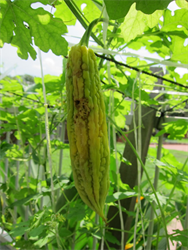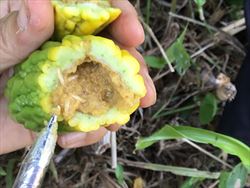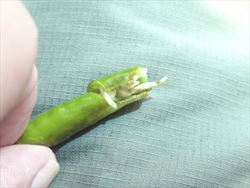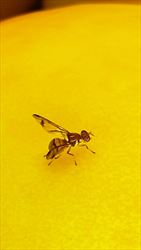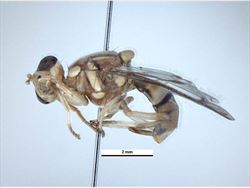- Widespread. Australia (Queensland), Guam, Kiribati, Nauru, MNI, PNG, Solomon Islands.
- Major invasive pest of cucumber family, also Solanum crops.
- Eggs (plus fruit fly-beneficial bacteria) laid in flowers and fruits giving a characteristic ‘sting’. Bacteria rot flesh providing food for maggots, and fruits usually fall to groundwhere larvae pupate. Adults, size of slender large house fly, bright yellow markings on thorax, T-shaped mark on abdomen, and smoky-brown marks at wing tips and back of wings along veins. Life cycle 3-5 weeks. Adults survive many weeks.
- Spread on the wing (moderately strong flier), and as larvae in infested fruit.
- Natural enemies: Psyttalia fletcheri (from India to Hawaii) - moderate mortality in Momordica, limited in cultivated fruit.
- Biosecurity: technologies and schemes to facilitate trade, including:
- post-harvest measures: HTFA (high temperature forced air); low temperature; insecticide dips; irradiation.
- area freedom, or area-wide management.
- consider in-country quarantines where melon fly is not widespread, or where countries free from melon fly border those infested.
- Cultural control: (i) monitor – trap male flies with pheromone (cure-lure); regularly check ripe fruit; (ii) protein baits – use yeast autolysate and insecticide as a spot spray; (iii) hygiene – bag fruit; harvest early; pick up fallen fruit, and remove those damaged but still on the crop, and destroy; (iv) crop rotation; (v) destroy remains of harvest.
- Eradication: define quarantine area; control fruit movement; remove fruit from trees and collect fallen fruit, protein bait/insecticide sprays; male annihilation; possibly SIT (sterile insect technique).
- Chemical control: protein bait (yeast hydrolysate) plus insecticide.

